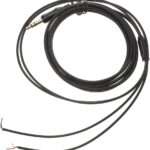Headphone technology advancements have revolutionized the way we experience music, providing modern listeners with an immersive audio journey.
In today’s fast-paced world, where we rely heavily on our devices for entertainment and communication, it is crucial to have headphones that can keep up with our needs.
From wireless connectivity to noise-canceling features, the advancements in headphone technology have truly elevated our audio experience to new heights.
Whether you are a music enthusiast, a gamer, or someone who simply enjoys the pleasure of listening to podcasts, these headphone technology advancements are designed to cater to your specific needs and preferences.
Let’s dive into the exciting world of headphone technology advancements and explore how they are shaping the way we listen to our favorite sounds.
Wireless Innovations
Headphone technology has evolved rapidly in recent years. Wireless advancements have transformed how we enjoy music. Cutting-edge technology offers convenience, high-quality sound, and freedom from wires.
Bluetooth Advancements
Bluetooth technology has seen significant improvements. The latest versions, like Bluetooth 5.0 and 5.1, offer faster data transfer. They also provide a more stable connection over longer distances. This means fewer interruptions and better sound quality.
Bluetooth advancements also support higher audio quality. Codecs like aptX HD and LDAC enable near-lossless audio transmission. This ensures you hear music just as the artist intended.
| Bluetooth Version | Benefits |
|---|---|
| 5.0 | Fast data transfer, stable connection, longer range |
| 5.1 | Improved accuracy in location tracking, better power efficiency |
True Wireless Earbuds
True wireless earbuds are a game-changer. They have no cables at all. Each earbud connects independently to your device. This gives you complete freedom of movement.
These earbuds come with advanced features. Many offer noise-cancellation, touch controls, and voice assistant support. Battery life has also improved. Some models provide up to 10 hours of playtime on a single charge.
- Noise-Cancellation: Blocks out background noise for a better listening experience.
- Touch Controls: Easily control your music and calls with simple taps.
- Voice Assistant Support: Activate Siri, Google Assistant, or Alexa without touching your phone.
True wireless earbuds are also designed for comfort. Many come with different ear tip sizes. This ensures a perfect fit for any ear shape.
Noise Cancellation
Headphone technology has evolved greatly, especially in noise cancellation. This feature helps to block unwanted sounds. It lets you enjoy your music or calls better. Two main types of noise cancellation are Active Noise Cancellation and Adaptive Noise Control.
Active Noise Cancellation
Active Noise Cancellation (ANC) uses microphones and speakers to reduce background noise. It listens to the sounds around you. Then, it creates an opposite sound wave. This cancels out the noise.
Here are some key features of ANC:
- Microphones that detect external sounds
- Speakers that generate anti-noise signals
- Works well for constant noises like airplane engines
Adaptive Noise Control
Adaptive Noise Control adjusts the noise cancellation based on your environment. It uses advanced algorithms. These algorithms detect changes in your surroundings. Then, it adjusts the noise-canceling levels automatically.
Advantages of Adaptive Noise Control:
- Smart adjustment to different environments
- Works with dynamic sounds like traffic or chatter
- Provides a more personalized experience
Comparing ANC and Adaptive Noise Control:
| Feature | Active Noise Cancellation | Adaptive Noise Control |
|---|---|---|
| Best For | Constant Noises | Dynamic Noises |
| Technology | Microphones and Anti-Noise Signals | Advanced Algorithms |
| Personalization | Less Personalized | Highly Personalized |
Both types have their strengths. Choose the one that fits your needs.

Sound Quality Enhancements
Recent advancements in headphone technology have vastly improved sound quality. These enhancements allow listeners to enjoy a richer, more immersive audio experience. Let’s explore the key developments in this area.
High-resolution Audio
High-resolution audio provides better sound quality than standard audio formats. It captures more details from the original recording. This results in a clearer, more natural sound.
High-resolution audio formats include:
- FLAC (Free Lossless Audio Codec)
- ALAC (Apple Lossless Audio Codec)
- DSD (Direct Stream Digital)
These formats offer higher sampling rates and bit depths. This means they can store more information from the original recording. The result is a more accurate and detailed sound.
3D Audio
3D audio creates a more immersive listening experience. It simulates sound coming from different directions and distances. This mimics how we hear sounds in real life.
Key technologies in 3D audio include:
- Dolby Atmos
- DTS:X
- Waves NX
These technologies use advanced algorithms to place sounds in a three-dimensional space. This makes the audio experience feel more lifelike and engaging.
For example, imagine hearing a plane flying overhead. With 3D audio, you can hear the sound move from one side to the other. This adds a new dimension to your listening experience.
These advancements in sound quality make modern headphones a joy to use. Whether you love music, movies, or games, better sound quality enhances your experience.
Smart Features
Smart features in headphone technology are changing how we experience audio. These advancements make headphones more than just listening devices. They now offer convenience, control, and connectivity.
Voice Assistants
Voice assistants are a game-changer in headphones. They allow hands-free operation, making tasks easier. With a simple voice command, you can play music, answer calls, or get information.
Popular voice assistants like Siri, Google Assistant, and Alexa are integrated into modern headphones. These features enhance user experience by providing instant access to information.
- Play Music
- Set reminders
- Send texts
The convenience of voice assistants is unmatched. You can multitask without touching your device. This feature is especially useful for people on the go.
Touch Controls
Touch controls are another smart feature in today’s headphones. They provide an intuitive way to manage audio and calls. Touch-sensitive panels on the earcups allow you to control your headphones with a swipe or tap.
| Action | Gesture |
|---|---|
| Play/Pause | Tap once |
| Next Track | Swipe forward |
| Previous Track | Swipe backward |
| Adjust Volume | Swipe up/down |
Touch controls eliminate the need for physical buttons. This makes the design sleek and modern. They also reduce wear and tear on mechanical parts.
Touch controls provide a seamless user experience. They allow quick adjustments without reaching for your device. This feature is perfect for quick interactions.
Battery Life Improvements
Recent advancements in headphone technology have significantly improved battery life. Users can now enjoy longer listening sessions without frequent recharging. These improvements have been driven by consumer demand and technological innovation.
Fast Charging
Fast charging technology has revolutionized headphone usage. With quick charge capabilities, users can get hours of playback in minutes. The table below highlights some popular models and their fast-charging features:
| Headphone Model | Charging Time | Playback Time |
| Sony WH-1000XM5 | 10 minutes | 5 hours |
| Bose QuietComfort 45 | 15 minutes | 3 hours |
| Apple AirPods Max | 5 minutes | 1.5 hours |
Fast charging is beneficial for those with busy schedules. It ensures their headphones are ready at a moment’s notice.
Extended Playtime
Extended playtime is another major advancement in headphone technology. Modern headphones offer up to 40 hours of continuous use on a single charge.
- Wireless headphones have seen the most significant improvements.
- Noise-canceling features no longer drain the battery quickly.
- Compact designs still manage to house larger batteries.
These improvements make headphones ideal for long trips, workouts, and daily commutes. Users can now enjoy uninterrupted audio experiences for longer periods. This is a game-changer for frequent travelers and audiophiles.
Comfort And Design
Headphone technology has advanced rapidly. Comfort and design now play key roles. Modern headphones offer more than just sound quality. They provide superior comfort and stylish designs. This enhances the overall user experience.
Ergonomic Designs
Ergonomic designs make headphones more comfortable. They fit the natural shape of your ears. This reduces pressure and pain during long use.
- Adjustable headbands: These allow for a custom fit.
- Swiveling ear cups: These adjust to the angle of your ears.
- Memory foam padding: This provides a snug yet gentle fit.
Material Innovations
Modern headphones use advanced materials. These materials improve comfort and durability. Below are some key innovations:
| Material | Benefits |
|---|---|
| Memory Foam | Conforms to ear shape, reduces pressure. |
| Lightweight Metals | Offers durability without adding weight. |
| Breathable Fabrics | Reduces sweat, keeps ears cool. |
Credit: resources.pcb.cadence.com
Connectivity Options
Headphone technology has advanced rapidly, offering many connectivity options. These advancements provide users with improved experiences and greater convenience.
Multi-device Pairing
Many modern headphones feature multi-device pairing. This allows users to connect to multiple devices simultaneously. You can switch between your phone and laptop effortlessly. This feature is perfect for people who multitask. It saves time and increases productivity.
Some popular headphones with this feature include:
- Bose QuietComfort 35 II
- Sony WH-1000XM5
- Apple AirPods Pro
Low Latency Modes
Low latency modes are crucial for gamers and video watchers. These modes reduce the delay between the source and the headphones. This ensures audio and visuals stay in sync. It enhances the overall experience, especially in fast-paced environments.
Here’s a quick comparison:
| Headphone Model | Latency (ms) |
|---|---|
| SteelSeries Arctis 7 | 20 |
| Sennheiser Momentum 3 | 30 |
| Razer BlackShark V2 | 25 |
These low latency modes ensure smooth and immersive experiences.
Sustainability Efforts
Headphone technology is evolving rapidly. One of the most exciting areas is sustainability. Companies are focusing on creating eco-friendly, energy-efficient products. This benefits both the environment and consumers.
Eco-friendly Materials
Many headphone brands are using eco-friendly materials. These materials include recycled plastics and metals. Some companies even use biodegradable elements. This reduces waste and lowers the carbon footprint.
Here is a table that shows some common eco-friendly materials used:
| Material | Source |
|---|---|
| Recycled Plastics | Old bottles, containers |
| Biodegradable Elements | Plant-based materials |
| Recycled Metals | Scrap metal |
These materials make headphones sustainable. They are safe for the environment.
Energy Efficiency
Energy efficiency is another key focus. Modern headphones use low-power technology. This means they consume less energy. Battery life is longer, and charging is less frequent.
Here are some benefits of energy-efficient headphones:
- Longer battery life
- Less frequent charging
- Lower electricity bills
Energy-efficient headphones are good for the planet. They are also convenient for users.
Frequently Asked Questions On Headphone Technology Advancements
What Are The Latest Headphone Technologies In 2024?
Headphone technologies, such as noise-cancellation, bone conduction, wireless charging, touch control, and audio sharing, are among the latest features available in headphones in 2024.
How Does Noise-cancellation In Headphones Work?
Noise-cancellation headphones use microphones to pick up external noise and create an opposite sound wave, which cancels out the noise, resulting in a quiet and peaceful experience.
What Is The Difference Between In-ear And Over-ear Headphones?
In-ear headphones are small and sit in your ear canal, while over-ear headphones fit over-ear and can provide better noise-cancellation and sound quality due to their larger drivers.
What Is Bone Conduction Technology In Headphones?
Bone conduction technology in headphones uses vibrations to transmit sound through your cheekbones directly to your inner ear, bypassing the eardrum, which is useful for those with hearing loss.
How Have The Headphones Changed Over Time?
Headphones have evolved from bulky over-ear designs to sleek, wireless models. Modern headphones offer better sound quality and noise-canceling features. They now include smart capabilities, such as voice assistants and touch controls. Battery life has also significantly improved.
What Is The Future Of Headphones?
The future of headphones includes advancements in wireless technology, noise cancellation, and smart features. Expect enhanced sound quality and longer battery life.
What Are The Technologies Used In Headphones?
Headphones use technologies like Bluetooth, noise cancellation, and wireless connectivity. They also feature drivers, microphones, and audio codecs for sound quality.
Do Headphones Improve With Use?
Yes, headphones can improve with use. This process, known as “burn-in,” may enhance sound quality over time.
Conclusion
Headphone technology advancements have revolutionized how we experience sound. From noise cancellation to wireless connectivity, the benefits are clear. Staying updated on these innovations can enhance your audio experience.
Embrace these advancements and elevate your listening sessions to new heights. Enjoy the perfect blend of convenience, quality, and cutting-edge technology.

A passionate tech blogger and the founder of Best Tech View, a dynamic platform dedicated to all things technology. With a keen interest in the tech, Ahmad strives to provide insightful and engaging content on the latest tech trends, and breakthroughs.


